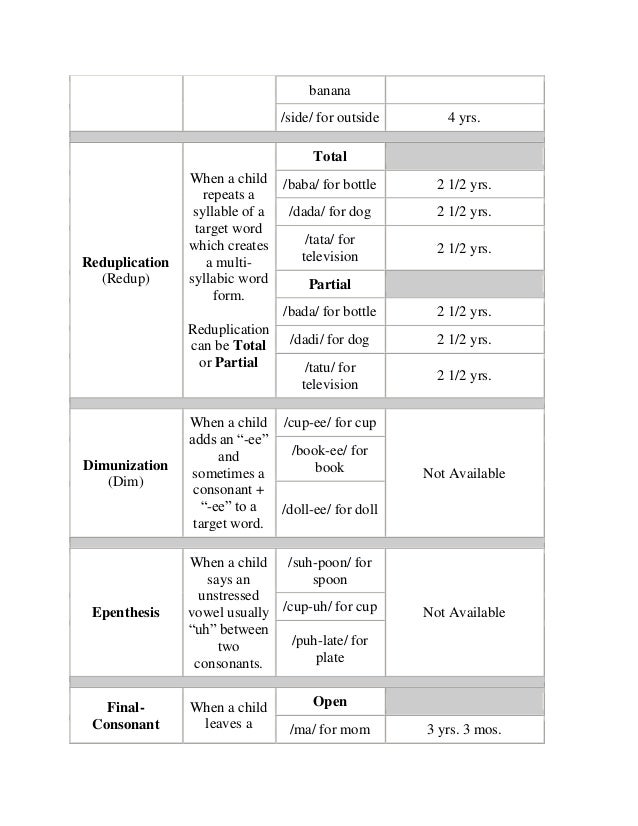
So what happens if a child displays phonological processes past the typical age of suppression? Or if a child is using an excessive amount of phonological processes, making it extremely difficult to understand him/her? These observations may be indicative of a phonological disorder. If you have a child and you are finding others are having a difficult time understanding him/her, it is useful to know how intelligible, or understandable, your child should be based on his/her age. Taken from: Developmental Speech and Language Norms for Spanish and English – Bilinguistics 2015” “Fabiano and Goldstein, 2010 Goldstein and Iglesias, 2006 Shriberg, 1995 When a liquid such as “r”, is replaced with a glide, such as “w” With /s/ - 5 0 yearswithout /s/ - 4 0 years

When a consonant cluster, like “cl”, is simplified into a single consonant When an affricate, like “ch”, is replaced with a fricative like “s” When the weak syllable in a word is omitted When a velar (sound made in back of mouth), like “k”, is replaced with an alveolar (sound made in the front of the mouth), like “t” f, s/ - 3 0 years/z, v/ - 4 0 yearssh, ch, j, th - 5 0 years

When a fricative like “f” is substitutedwith a stop consonant like “p” When a non-nasal sounds like “y” changes to a nasal sound like “m”, due to the presence of a nasal sound within a word When a non-velar sound like “t”, changes to velar sound (sound made in back of the mouth), like “k”, due to the presence of a velar sound within the word When the final consonant in the word is omitted Table 2 – Most Common Phonological Processes Common Phonological ProcessĪge of Elimination for Monolingual English Speakers (ASHA, Shriberg)Īge of Elimination for Bilingual English-Spanish Speakers (Goldstein+) Below please find Table 2 for more information on the most common phonological processes with the approximate ages at which children suppress them, both for monolingual English speakers and for bilingual English-Spanish speakers. There are a variety of phonological processes that fall within each of these three categories, and the majority of children will suppress each distinct phonological process around the same age-range. The resemblance of syllables/sounds to surrounding sounds (e.g., “Sippy Cup” → “Pippy Pup”) The reduction, omission, or repetition of syllables in a word(e.g., “Star” → “Tar”) The replacement of one class of sounds, with another class of sounds (e.g., “Get” → “Det”) Table 1 provides a description of these three different types: Phonological processes have been classified into three different types of categories: substitution processes, syllable structure processes, and assimilation processes. In fact, it is arguably more surprising to see a 2-year old with “perfect” adult speech, than it would be a 2-year old with sound errors. These patterns are completely natural and expected. Childrens’ brains learn these patterns of speech sound errors, which are called phonological processes.

As children develop speech-language skills, they simplify words until they have learned to articulate all sounds in words appropriately. Why does this happen? While learning to coordinate the tongue, lips, jaw, teeth, and palate to make speech sounds, all children will display speech sound errors.
PHONOLOGICAL PROCESSES DEVELOPMENT CHART PROFESSIONAL
Colleagues everywhere are welcome to join the private Facebook group E3BPforSSD for professional discussion of speech development and disorders.Have you ever heard your child say words like “wain” for “rain”, or “pane” for “plane”? For some, it can be extremely cute to hear a child speak in this manner, and while it’s a natural characteristic of speech development, it’s definitely something worth learning more about. Please read the policy on questions from SLPs/SLTs on child speech assessment and intervention. The site is made possible through the kindness of donors. Its mission is to provide useful, theoretically sound, and where possible evidence-based information about the assessment and treatment of human communication disorders. The site's intended audience is families and others close to children with voice, speech, language, literacy, and fluency difficulties, and people working in the field of communication sciences and disorders. Children's Speech Sound Disorders, 3rd ed., Wiley-Blackwell. She is also interested in developmental language disorder, the role of families in intervention, and evidence-based practice vs. She retired from clinical practice in 2011, maintaining her interests in presenting CPD and writing about children's speech sound disorders ( 2023 book). The content reflects the professional, clinical and teaching activities and small body of research ( ORCiD) of the site owner, Caroline Bowen. Welcome to the home page of Dr Caroline Bowen's Since 1998 has provided information and resources to Speech-Language Pathologists / Speech and Language Therapists, students, and consumers of SLP/SLT services worldwide.


 0 kommentar(er)
0 kommentar(er)
